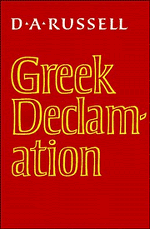5 - Character and characters
Published online by Cambridge University Press: 07 October 2011
Summary
ʾΩς εἰπεῖν τῷήτορι μόνος ὁ τοῡ ῆθους ἀγών ἐστιν.
‘To all intents and purposes, the conflict of character is the rhetor's only conflict.’
Ps.-Dionysius, Art of RhetoricThe importance of character (ēthos) in oratory was very familiar both to the Attic orators and to the early teachers of rhetoric. It was important in three ways.
First, the speaker had to project a sympathetic image of himself. He needed to seem likable and – even more important – trustworthy.
Secondly, in order to ensure that he was really making the desired impression, he had to identify and study the specific qualities of his audience – age, interests, and nationality as well as what we should call qualities of character. He had to know, for example, how they would respond to pleas based on patriotism or self-interest.
Thirdly, he had to represent the characters of his opponents, and of other people appearing in his story, in such a way as to make his narrative plausible and make sure that it was understood as he wanted it to be.
Declamation, because it was a toy model of oratory, had the same concerns, but on a different level. For one thing, the declaimer has to invent his character. He does not stand forth as a real person with obvious characteristics which can be seen by all. Hermogenes significantly lists the creation of a distinct ēthos in the speaker as the first criterion to be fulfilled, if the case is to ‘hang together’.
- Type
- Chapter
- Information
- Greek Declamation , pp. 87 - 105Publisher: Cambridge University PressPrint publication year: 1983



